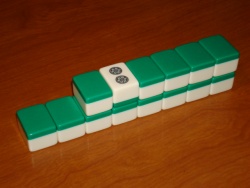Japanese mahjong setup: Difference between revisions
mNo edit summary |
|||
| Line 1: | Line 1: | ||
The game of [[Japanese mahjong]] is played with a set of 136 tiles. Of these 136 tiles, there are 34 different tiles with 4 of each kind. Aside from online, the live game is played on a square table, with the mahjong tiles places onto a mahjong mat. While the mat is not necessary, it is useful to use the mat in order to protect the tile surfaces. | The game of [[Japanese mahjong]] is played with a set of 136 tiles. Of these 136 tiles, there are 34 different tiles with 4 of each kind. Aside from online, the live game is played on a square table, with the mahjong tiles places onto a mahjong mat. While the mat is not necessary, it is useful to use the mat in order to protect the tile surfaces. | ||
<!--eventually, I'll bring in pictures to illustrate these directions--> | <!--eventually, I'll bring in pictures to illustrate these directions--> | ||
==Building walls and breaking the wall== | ==Building walls and breaking the wall== | ||
Revision as of 18:28, 19 June 2015
The game of Japanese mahjong is played with a set of 136 tiles. Of these 136 tiles, there are 34 different tiles with 4 of each kind. Aside from online, the live game is played on a square table, with the mahjong tiles places onto a mahjong mat. While the mat is not necessary, it is useful to use the mat in order to protect the tile surfaces.
Building walls and breaking the wall
At the beginning of each hand, the tiles are shuffled and arranged into walls. After shuffling, tiles are arranged into 4-double stacked rows of 17-tiles faced down. Every player has the responsibility of building their own walls arranged in front of them. Once the walls are built, the dealer determines the initial breakage of the wall using a dice roll. Once again, starting with the dealer, the count begins at 1 and the count moves clockwise. Then the wall of the player at the end of this count is broken, where the player counts with the same dice number from the first tile on the right side of his/her wall towards the left.
The dead wall and dora

Then the dead-wall must be set. From the point of the initial wall break, players count 7-tiles to the right of the initial break; and the wall is broken again. There should be a total of 14-tiles (7-tiles double stacked) in this group. This is the dead wall, which consists of tiles set aside and not used in the regular draw. Finally, the third tile closest to the inital break is flipped over and used as a dora indicator.
Dealing the tiles
From the initial break, the dealer (East) begins by taking a group of 4 tiles from the regular wall. The South takes the next group of 4. Then West with 4 more, and North with 4 more. This procedure is repeated 2 more times, to ensure an initial deal of 12-tiles for each player. At this point, the dealer East takes the first and third tiles on the top row of the wall. South takes the next available draw, then West, and finally North. At this initial deal of the tiles, the dealer East should have 14 tiles; and the rest have 13. The game hand begins with the dealer discarding 1 tile.
Players are recommended to arrange their tiles according to suit, but it is not necessary. Some players are able to read their hands with the tiles in randomized order.
Automatic tables
Sometimes, the automatic table is used. These tables include one or two sets of tiles, with different colored backs. The table uses magnets to properly align the tiles face down. These tables randomly and conveniently arrange the tiles into the 4 separate walls. With push of the red button, four 17x2 walls of shuffled tiles rise up from below. With the push of a red button on the central island, it rises up and the discard ponds collapse to allow players to push tiles into the mixer below.
The automatic table includes one or two sets of tiles, with blue or orange backs. With the push of a red button on the central island, it rises up and the discard ponds collapse to allow players to push tiles into the mixer below. With another push of the red button, four 17x2 walls of shuffled tiles rise up from below. Automatic tables are real and not that uncommon. However, they are rather expensive, with the cheapest tables priced around ¥2000, or roughly $2000 or so.
Some automatic tables are capable of keeping score, based on point sticks stored in four pull out compartments. In the event of riichi, the central island has four slots where 1000-point stick rīchi bets can be placed. In front of each player, an display shows the player's current score.